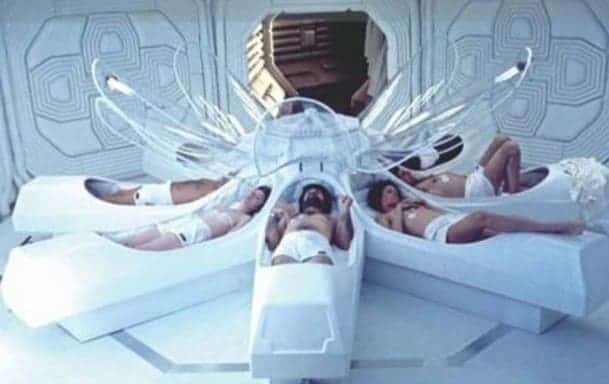
Suspended animation sounds like science fiction, but there are quite a few non-human animals that have the ability to enter in this low-metabolic state, including mice. Two studies have independently shown that the activation of certain neurons can induce a hibernation-like state in mice, hinting that the same might also be possible someday for humans. The implications would be far-reaching, with applications ranging from clinical medicine to interstellar space travel.
The ultimate slumber
Hibernation is essentially a resting state of deep sleep, during which the body’s metabolic rate and temperature drop considerably. For instance, during hibernation, the gopher’s body temperature will drop from its normal 37 degrees Celsius to almost 0 degrees Celsius. The heartbeat also becomes slow and irregular, alongside a slowing breathing rate.
Since the body’s metabolic functions slow to a crawl, the hibernating animal can survive for extended periods of time — sometimes months — without having to ingest food. This is why hibernating animals like bears and squirrels consume copious amounts of calories in the months leading to the hibernation season.
However, true hibernation is actually very rare, occurring only in a few mammals and one bird species, the poorwill (Phalaenoptilus nuttallii). Instead, most mammals that enter a hibernation-like state are actually in a torpor state.
Torpor is a lighter version of hibernation. While it also involves lowering body temperature, breathing rate, heart rate, and metabolic rate, it is activated involuntarily when an animal sense certain environmental conditions. In contrast, truly hibernating animals can do so rather voluntarily without having to be prompted by temperature or other external stimuli.
And, unlike hibernation, torpor lasts for short periods of time, sometimes just through the day or night, depending on the animal’s feeding patterns.
For example, mice can enter torpor — and two new studies from researchers at the University of Harvard and the University of Tsukuba in Japan not only show how this deep sleep state is triggered in the brain, but also how it can be activated at will by stimulating certain neurons.
In the first study, which was published in the journal Nature, the Japanese researchers genetically engineered mice so they could activate a set of neurons in the hypothalamus — known as Q neurons — by shining light onto them.
When these neurons were activated, the rodents’ body temperature fell 10 degrees Celsius or more and their pulse dropped considerably, as well as their metabolic rate and breathing rate.
The mice stayed in this torpor state for more than 48 hours. Once they returned to their normal waking state, the rodents behaved normally, with no visible signs of physical harm. The researchers in Japan repeated the experiment in rats, with similar results.
These experiments allowed the scientists to map the circuits of neurons involved in the process. The same technique could be used in the future to induce torpor-like states in other animals, perhaps even in humans.
Artificially inducing torpor in humans would have a wide range of applications. The most immediate is in medicine, where a hibernation-like state could protect patients who recently suffered a heart attack or stroke from debilitating or life-threatening tissue damage. Torpor could also dramatically extend the preservation of organs for transplants.
But, going back to sci-fi, perhaps the most intriguing and impactful application of torpor in humans is deep-space travel.
With our current propulsion technology, it would take us between 1,000 and 81,000 years to traverse the 4.24 light-years between Earth and Proxima Centauri, our closest star beside the Sun. If we’re ever to become an interstellar species, this travel time has to be dramatically reduced. Even then, humans would be expected to stay confined in their spaceship for years, so having extended periods of hibernation-like sleep could make the journey a lot more bearable.
Meanwhile, at the Harvard Medical School, researchers there reached a similar conclusion, showing that stimulation of neurons in brain regions that regulate hunger, feeding, body temperature, and many other functions can force mice to enter torpor for days. During their experiments, the researchers managed to induce torpor even in well-fed mice. When the activity of these neurons was blocked, natural torpor activity was disrupted.
It’s worth noting that rather than genetically engineering the mice, the Harvard researchers injected 54 mice with a tiny amount of a virus into 226 different regions of the hypothalamus. They learned that torpor was triggered when neurons in one specific region of the hypothalamus, known as the avMLPA, were activated. Stimulation neurons in other areas of the hypothalamus had no effect, the researchers wrote in their paper, also published in the journal Nature.
“The imagination runs wild when we think about the potential of hibernation-like states in humans. Could we really extend lifespan? Is this the way to send people to Mars?” study co-lead author Sinisa Hrvatin, an instructor in neurobiology in the Blavatnik Institute at the Harvard Medical School, said in a press release.
“To answer these questions, we must first study the fundamental biology of torpor and hibernation in animals,” Hrvatin said. “We and others are doing this—it is not science fiction.”
Both studies have made tremendous contributions in advancing our understanding of how torpor or hibernation are regulated in the brain. Now that scientists have a better graps of the underlying biology of torpor, they can now think of applications in humans.
“It’s far too soon to say whether we could induce this type of state in a human, but it is a goal that could be worthwhile,” said senior author Michael Greenberg, also from the Department of Neurobiology in the Blavatnik Institute at the Harvard Medical School.
“It could potentially lead to an understanding of suspended animation, metabolic control and possibly extended lifespan. Suspended animation in particular is a common theme in science fiction, and perhaps our ability to traverse the stars will someday depend on it.”






